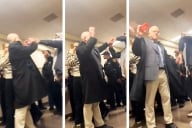You have /5 articles left.
Sign up for a free account or log in.
In a decision overturning last year’s jury verdict in a wrongful death lawsuit against the state, the Virginia Supreme Court said Thursday that “there was no duty for the Commonwealth to warn students about the potential for criminal acts” by Seung-Hui Cho, the student who killed 32 people and himself at Virginia Tech in 2007.
The lawsuit was filed by the families of two students killed in the shooting. A Montgomery County Circuit Court jury ruled last year that the university was negligent in waiting to inform the campus about the gunman, and that the families of Julia Pryde and Erin Peterson should receive $4 million each (at the state’s request, the amount was later reduced to $100,000). Administrators waited more than two hours after the first two students were shot in a dorm before sending a campuswide alert, which did not indicate a gunman might still be at large.
“[The families] alleged that a special relationship existed between the Commonwealth’s employees at Virginia Tech and Peterson and Pryde that gave rise to the Commonwealth’s duty to warn Peterson and Pryde of third party criminal acts and that the Commonwealth’s failure to warn them was the proximate cause of their deaths,” the decision says. “The Commonwealth argued that there was no foreseeable harm to the students and that the evidence failed to establish that any alleged breach of a duty of care was the proximate cause of the deaths.”
The Supreme Court identified two major reasons to overturn the initial ruling: a misunderstanding of Virginia law by jurors, and the lack of information available to campus police officers at the time of the shootings.
Despite the circuit court instructing jurors to the contrary, neither the university nor the state had a special relationship with the students, which would have imposed on them a corresponding responsibility, the decision says. And even if they did, “the evidence adduced did not give rise to a duty to warn of third party criminal acts.”
“The circuit court’s instructions … misstated Virginia law regarding the existence of a relevant special relationship, the existence and type of duty purportedly owed, the standard that triggers a duty to warn of third party criminal acts, as well as regarding the reasonable expectation of parents and students at a university, and therefore, the jury’s verdict must be overturned,” the decision says.
And because police officers on the scene believed that the residence hall shooting was an isolated domestic incident and that the shooter had fled the area, the court said, “it cannot be said that it was known or reasonably foreseeable that students in Norris Hall would fall victim to criminal harm. Thus, as a matter of law, the Commonwealth did not have a duty to protect students against third party criminal acts.”
The wrongful death lawsuits originally targeted the state in addition to 18 other individuals, including Virginia Tech President Charles W. Steger, but the cases were eventually consolidated and the Commonwealth became the sole defendant.
University and state officials said they were pleased with the decision. Steger spoke specifically about staff members in the attorney general’s office.
“Their attention to detail throughout the case -- indeed throughout the lengthy fallout from this wrenching tragedy -- and their belief in the university’s employees is gratifying and much appreciated,” Steger said in a one-paragraph statement.
The VTV Family Outreach Foundation, established by families of victims and those affected by the shooting, issued a statement saying “Federal authorities have made it clear that existing law, the Jeanne Clery Act, required a more timely notice in the event of a very serious crime, such as when an unknown shooting suspect remains at-large.”
Following the discovery of two gunshot victims in a campus dorm, the Blacksburg Police Department, joined by at least one member of the Virginia State Police, began an investigation. Because there were no signs of forced entry, the court decision says, police initially thought it was an isolated incident. They focused immediately on the female victim’s boyfriend, believing the shootings were “likely domestic in nature.” Police said as much to Steger, who about an hour after the 7:30 a.m. shooting was meeting with a group of administrators who worked on campus safety.
According to the decision, around that time Executive Director for Government Relations Ralph Byers was emailing the governor’s office about the situation. “Not releasable yet,” Byers wrote, as the university worked on its news release. “One student dead, one wounded. Gunman on loose…. State police are involved. No details available yet.”
Byers said afterward that he meant “[g]unman on the loose” to mean “perpetrator has not been apprehended.”
Administrators wanted to tell the victims’ families what had happened before notifying the campus, the decision says. A campus notice was sent out at 9:26 a.m. It referred to a “shooting incident” in the dorm and said police were investigating, and students should be alert to anything suspicious.
Nineteen minutes later, Cho chained the doors of Norris Hall shut and began the mass shooting, the decision says. Five minutes after that, at 9:45 a.m., administrators sent another campuswide email stating that a “gunman is loose on campus. Stay in buildings until further notice. Stay away from all windows.”
Peterson, 18, and Pryde, 23, were among those shot and killed in Norris Hall.
Police later discovered that Cho was responsible for both the Norris Hall shooting and the dormitory shooting.
"While words cannot express the tremendous sympathy we have for the families who lost their loved ones in the Virginia Tech shootings of 2007 – including the Prydes and the Petersons – the Virginia Supreme Court has found what we have said all along to be true,” said Brian Gottstein, director of communications for the attorney general’s office. “The Commonwealth and its officials at Virginia Tech were not negligent on April 16, 2007. Cho was the lone person responsible for this tragedy.”








